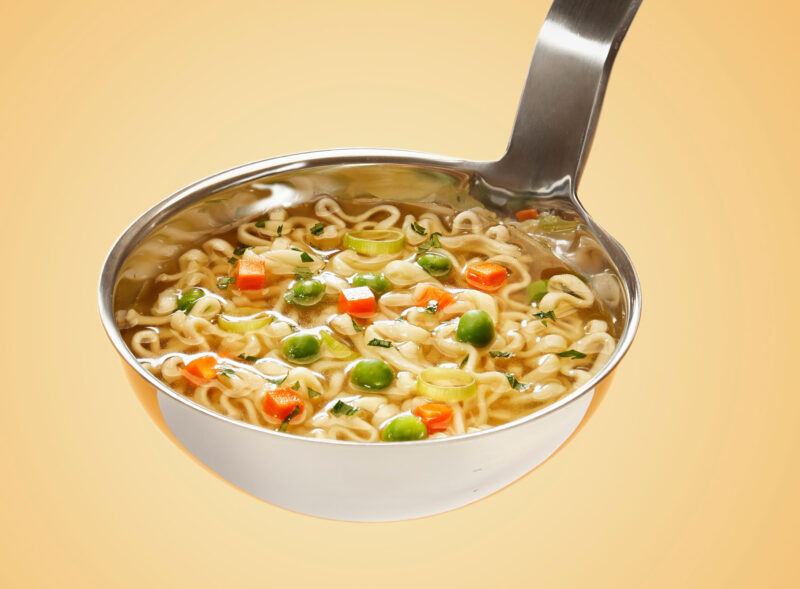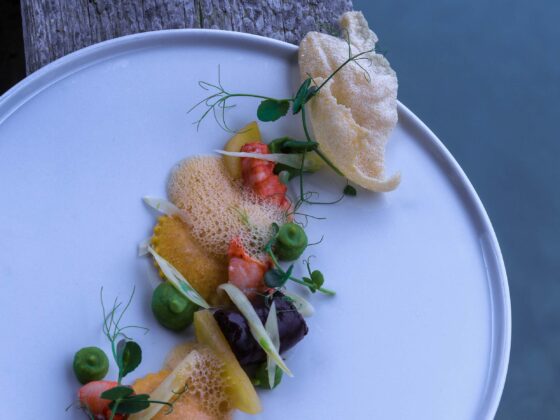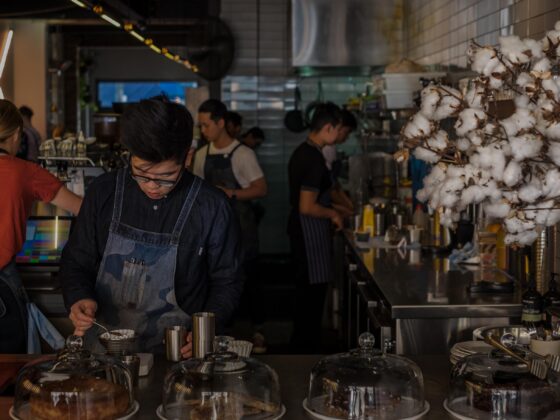Have you ever wondered why we feel a sensation of high when we eat spicy food? Or why fat makes everything taste better? Why food tastes bland on planes, or why tomato juice is so popular? This article will provide you with 35 absolutely fascinating science-backed food facts. Are you ready?
It’s not you, it’s your brain
1. We often say that ‘the best memories are made around the table’. The reason for this is that eating together leads to the release of endorphins which are responsible for social bonding and general well being. 1
2. Are you a lover of potato crisps and other crispy treats? Science has found that the crunchier the food, the better its perceived flavour. As a matter of fact, some of the products on the market have been specifically engineered to sound crunchier.


3. Studies have shown that round plates make our brain think the food served on them tastes sweeter than food served on square plates.
4. Food loses about 30% of its flavour when tasted in the sky. This is caused by the lack of humidity in the air, which decreases our ability to use our orthonasal and retronasal olfaction to taste flavour, which help us perceive flavour and aroma. This explains why food tastes so bland while on a plane.


5. Have you ever wondered why tomato juice is so popular on planes? Research shows that loud noises (such as the plane engines) tend to enhance the perception of umami2, found in tomato juice.
6. Music affects our perception of taste. Some chefs use ‘sonic seasoning’ to influence the way guests perceive the flavour of a dish. However, loud noises reduce our ability to taste sweet, salty and in some cases sour.
Taste and flavour
7. Flavour is not limited by our tongue’s ability to taste sweet, salty, bitter, sour and umami. As a matter of fact, flavour is the convergence of smell and taste. The aroma in food is perceived through gustation (through taste receptors in the mouth), orthonasal olfaction (smelling the food through the nose), and retronasal olfaction (where the odour molecules travel through the back of your mouth and into the nose). This is why food tastes bland when we have a cold or a stuffed nose. Likewise, straws also inhibit our orthonasal and retronasal olfaction! And this is why breathing out into the mouth after tasting something can enhance the overall flavour.
8. Umami is the taste of glutamic acid, naturally found in meat, roasted or dried tomatoes, parmesan, mushrooms and soy sauce. It has officially been recognised as a taste of its own ten years ago. MSG is chemically produced glutamic acid (monosodium glutamate) and was developed at the beginning of the 20th Century by Japanese chemist Ikeda Kikunae. MSG’s health risks have been debated as its popularity has grown.
9. Recent research suggests that we have a carbohydrate taste receptor, in addition to the ones for sweet, salty, sour, bitter, umami, heat and fat (see facts 10 and 23). Indeed, thanks to recent research, the ‘tongue map’ that only maps out our perception to taste sweet, salty, sour and bitter has become obsolete.
On fat
10. ‘When in doubt, add butter’. Whoever said that, was a wise person. Fat does, indeed, make most things taste better because some flavour molecules (often volatile compounds) bind to the fat molecules, giving them a prolonged and stronger taste. More than that, because fat often leads to crunchier (like a potato chip) or creamier (like mayo), it is perceived by the brain to enhance flavour.
11. Our mouths have fat receptors, just like they have receptors for salt, sugar, sour, bitter, umami, heat and carbs. These receptors are called CD36.
On bitterness
12. There are three types of people based on their perception of bitterness: non-tasters, medium-tasters and supertasters. These characteristics are genetically inherited traits. While non-tasters’ ability to perceive bitterness is the lowest, supertasters’ is the highest. Supertasters also have about twice as many taste buds as non-tasters or medium-tasters.
13. Children’s dislike for bitter foods is a coping mechanism to protect them from ingesting poisons, since toxins are often bitter. The genes responsible for humans to get used to bitter flavours develop and change with age.
On sweetness
14. The sweetness of liquorice root comes from glycyrrhizin, a compound that is 50-100 times sweeter than sucrose. This compound also helps enhance flavours in food and, just like salt, reduces bitterness.
And the pinch of salt
15. Salt masks bitterness much better than sugar. So, next time you want to reduce the bitterness of your coffee, how about you try adding a bit of salt instead of sugar?
16. Salt is a universal flavour enhancer. It is the Na+ cation that gives its saltiness and the Cl- anion that modulates its strength.
17. Salting a steak before or after cooking leads to the same result in flavour and texture, since salt has been proven to move out of the meat rather than inside the fibre, as is widely thought in the culinary world.3
Around the kitchen: cooking and the like
18. The sear on food is produced by the Maillard reaction, which occurs at 140ºC and enhances both the texture and the flavour of the seared food. The Maillard reaction is the chemical reaction between the amino acids (the compounds that form proteins) and reducing sugars found in food.
19. The reason why you can only caramelise fruits and vegetables in dry heat and not in water is because the process of caramelisation happens at 160ºC, whereas water boil at 100ºC. This means that boiling water is not enough to start the caramelisation process.
20. Onions, garlic, shallots, chives and leeks contain sulphur compounds, giving them their specific smell and flavour.
21. Crushing garlic will give it a stronger flavour. Garlic contains sulfoxide alliin, which gets transformed into allicin when crushed or chopped. Allicin then further transforms into the sulphide compounds that give garlic its specific taste. The more brutal the rupture, the more sulphide compounds! This means that crushing the garlic clove with a knife and then further mincing it with a crusher will probably lead to the strongest garlic flavour.4

It’s all in the spice
22. The burning sensation of spiciness is either produced by capsaicin (the spicy compound of chillies) or allyl isothiocyanate in mustard, wasabi and horseradish. The latter is a volatile compound whose receptors are found inside the nose, making its effects felt inside the nose and sinuses. Capsaicin is an oil-based molecule that is mostly felt on the tongue. This is why wasabi, mustard and horseradish feel like they’re burning your nose, and chillies, your tongue.
23. The reason why spiciness is associated with heat is because they both interact with the same receptor, TRPV1. And in case you were wondering, yes, these receptors are present only in the mouth and the anus.


24. When consuming hot chillies, the TRPV1 protein signals the ‘burning sensation’ to the brain, which then initiates the release of endorphins and dopamine. Endorphins are responsible for blocking the transmission of pain and dopamine for pleasure and reward. This is why you often feel euphoric or feel a sensation of high after eating spicy food.
25. Milk based products (milk, yogurt, cream, ice cream) are the best reliever of spiciness thanks to a protein called casein. This ‘fat-loving’ molecule binds to the capsaicin molecules, surrounds them and washes them away. Neither water nor beer contain casein, which makes them ineffective after eating too spicy.
26. Capsaicinoids are chemically related to vanillin (the compound that gives vanilla its specific taste). They are also part of the vanilloid family.
Infamous foods
27. Beans produce gas because they contain a type of sugar (oligosaccharides) that, when broken down during digestion, leads to fermentation and therefore the production of CO2.


28. It is natural for humans to stop producing lactase, the enzyme responsible for the digestion of lactose during adulthood. Lactose tolerance is in fact a mutation, not the other way around. Only about 35% of adults worldwide are lactose tolerant.
29. Humans became lactose tolerant when they stopped being hunter-gatherers and started domesticating animals, 10,000-13,000 years ago. This mutation spread to a larger population through natural selection.
Other curiosities
30. As most of you will know, sourdough starter (the yeast base added to sourdough bread) is a mixture of water and flour that, once left outside, ferments thanks to natural yeasts and bacteria from the air. Just like wine, sourdough’s terroir will influence the flavour. So, if you culture the same batch of flour and water in two different places, the taste of the sourdough will be different, and so will the bacteria and yeasts that helped with fermentation.
31. Blowing in your hot drink or lifting it with your spoon is more efficient to cool it down that stirring. Stirring adds kinetic energy to the drink, thus increasing its temperature.
32. The glass that gives the best results for both white and red wine tasting is the ISO glass, contrary to the beliefs that one should drink red wine from larger glasses and white from smaller. The ISO glass allows less wine oxygenation than other types of glasses, which ultimately leads to a more stable oxygen with time, which will ultimately intensify the aromas of the wine.


33. Cooked foods contain more calories than raw foods. This is because the process of cooking makes food easier to chew and digest, which ultimately means that our bodies use less energy in the eating process.
The banana problem
34. Although there are 1,000 types of bananas, only one type makes up almost the entire export market around the world. This variety is called Cavendish.
35. Cavendish banana is on the brink of extinction, and here is why: banana plants are sterile and can only reproduce through cloning. This means that their DNA is identical from one plant to the next. Therefore, all plants of one type are equally prone to the same diseases. Recently, scientists have found a fungus that only affects Cavendish bananas and that resists pesticides and lives in the soil. The only solution to save the most popular type of banana is for scientists to genetically modify the plant and make it resistant to the fungus.
- Prof Dr Charles Spence, Gastrophysics, p. 136
- Prof Dr Charles Spence, Gastrophysics, p. 152
- Hervé This, Molecular Gastronomy, p. 51
- Niki Segnit, The Flavour Thesaurus, p. 111
Time for science
The world of taste, perception of flavour, cooking chemistry, and our biological predispositions to food are all fascinating subjects. As food becomes trendier, so does the science that researches it. Molecular gastronomy, neurogastronomy and gastrophysics are in charge of understanding the science of food and how we eat.
Still curious to learn? I’ve got a couple of resources for you:
- Here is an introduction to pet nat, the trendiest, yet ancestral bubbly.
- Here you will find out about the beautiful and diverse Georgian cuisine.
- This super in depth guide will help you plate dishes like a fine dining chef.




